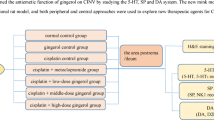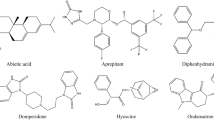Abstract
The efficacy of thalidomide to attenuate cisplatin-induced emesis was evaluated in a rat model. Four groups were utilized: control group (peritoneal injection and gastric lavage with normal saline), cisplatin group (peritoneal injection of cisplatin at 10 mg/kg and gastric lavage with normal saline), thalidomide group (cisplatin as above and gastric lavage with thalidomide at 10 mg/kg), and granisetron group (positive control for antiemetic effects; cisplatin given as above and gastric lavage done with granisetron at 0.5 mg/kg). The cisplatin-induced kaolin consumption (pica behavior) was used as a model of emesis in patients. The animals’ kaolin and food intakes were measured. Further, medulla and gastric tissues were obtained 5 and 33 h after peritoneal injections to quantify the levels of Substance P and Neurokinin-1 receptor (NK-1R). The cisplatin-induced kaolin consumption was significantly (p < 0.05 vs. cisplatin group) attenuated by thalidomide 72 h after the injection. The levels of Substance P in the medulla and gastric tissue were increased 5 h after the injection in both cisplatin and thalidomide groups, however, returned faster to normal levels in the thalidomide group (p < 0.05 vs. cisplatin group). Further, levels of NK-1R in the cisplatin, thalidomide, and granisetron group were significantly increased at both 5 and 33 h (p < 0.05 vs. control group), with no obvious difference among these three groups. In conclusion, thalidomide attenuates animal equivalent of cisplatin-induced emesis, and this beneficial effect is associated with decreased levels of Substance P levels in the medulla and gastric tissue.

Similar content being viewed by others
References
Reid, J., Mills, M., Cantwell, M., Cardwell, C. R., Murray, L. J., & Donnelly, M. (2012). Thalidomide for managing cancer cachexia. Cochrane Database of Systematic Reviews, 4, CD008664.
Badros, A. Z. (2012). Lenalidomide in myeloma—a high-maintenance friend. New England Journal of Medicine, 2012(366), 1836–1838.
Young, R. J., Tin, A. W., Brown, N. J., Jitlal, M., Lee, S. M., & Woll, P. J. (2012). Analysis of circulating angiogenic biomarkers from patients in two phase III trials in lung cancer of chemotherapy alone or chemotherapy and thalidomide. British Journal of Cancer, 106, 1153–1159.
Takeda, N., Hasegawa, S., Morita, M., & Matsunaga, T. (1993). Pica in rats is analogous to emesis: an animal model in emesis research. Pharmacology, Biochemistry and Behavior, 45, 817–821.
Takeda, N., Hasegawa, S., Morita, M., Horii, A., Uno, A., Yamatodani, A., et al. (1995). Neuropharmacological mechanisms of emesis. II. Effects of antiemetic drugs on cisplatin-induced pica in rats. Methods and Findings in Experimental and Clinical Pharmacology, 17, 647–652.
Aung, H. H., Dey, L., Mehendale, S., Xie, J. T., Wu, J. A., & Yuan, C. S. (2003). Scutellaria baicalensis extract decreases cisplatin-induced pica in rats. Cancer Chemotherapy and Pharmacology, 52, 453–458.
Yuan, C. S., Wang, C. Z., Mehendale, S. R., Aung, H. H., Foo, A., & Israel, R. J. (2009). Protease inhibitor-induced nausea and vomiting is attenuated by a peripherally acting, opioid-receptor antagonist in a rat model. AIDS Research and Therapy, 6, 19.
Jordan, K., Sippel, C., & Schmoll, H. J. (2007). Guidelines for antiemetic treatment of chemotherapy-induced nausea and vomiting: past, present, and future recommendations. Oncologist, 12, 1143–1150.
Musso, M., Scalone, R., Bonanno, V., Crescimanno, A., Polizzi, V., Porretto, F., et al. (2009). Palonosetron (Aloxi) and dexamethasone for the prevention of acute and delayed nausea and vomiting in patients receiving multiple-day chemotherapy. Supportive Care in Cancer, 17, 205–209.
Hesketh, P. J., Van, B. S., Aapro, M., Tattersall, F. D., Naylor, R. J., Hargreaves, R., et al. (2003). Differential involvement of neurotransmitters through the time course of cisplatin-induced emesis as revealed by therapy with specific receptor antagonists. European Journal of Cancer, 39, 1074–1080.
Saito, R., Takano, Y., & Kamiya, H. O. (2003). Roles of substance P and NK(1) receptor in the brainstem in the development of emesis. Journal of Pharmacological Sciences, 91, 87–94.
Conflict of interest
Authors declare no conflicts of interest.
Author information
Authors and Affiliations
Corresponding authors
Additional information
Zheng-xiang Han, Jie Xu and Hong-mei Wang contributed equally to this study.
Rights and permissions
About this article
Cite this article
Han, Zx., Xu, J., Wang, Hm. et al. Antiemetic Role of Thalidomide in a Rat Model of Cisplatin-Induced Emesis. Cell Biochem Biophys 70, 361–365 (2014). https://doi.org/10.1007/s12013-014-9921-8
Published:
Issue Date:
DOI: https://doi.org/10.1007/s12013-014-9921-8




